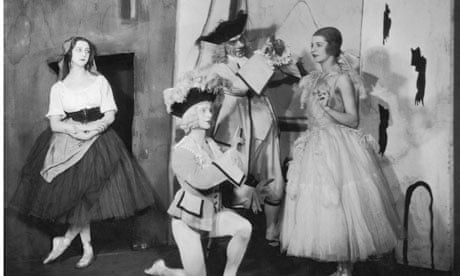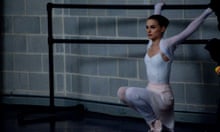Sergei Diaghilev's Ballets Russes sparked a revolution in taste after the first world war, taking modernism out of the salon and into the music hall. The splendid exhibition Diaghilev and the Golden Age of the Ballets Russes, currently showing at the V&A, covers the impresario's legacy in music, dance, fashion, painting, and literature; but less well documented is the spell he cast over British film. Michael Powell, who drew on 1920s memories of the Diaghilev milieu for The Red Shoes, was just one among a generation of cineastes who found inspiration in the same source.
Ballet sequences held a special appeal for the likes of Anthony Asquith and Thorold Dickinson, who cast the young Audrey Hepburn as a ballerina in Secret People; but their interest went beyond merely recording dance on film. Rather, argued Asquith in an ingenious essay teasing out the two art forms' "common element – rhythm", the idea was to reach a stage where "the whole film will dance". Critics had been pointing out the parallels and agitating for Diaghilev to put his troupe on screen almost since his first arrival in western Europe.
Caroline Lejeune, for example, in her maiden film piece for the Manchester Guardian in 1921, discovered a "beauty of line" in Douglas Fairbanks's swashbuckling performance in The Mark of Zorro "strongly reminiscent of M. Diaghilev and the Russian Ballet". And in a roundabout way it was the great Fairbanks who brought Diaghilev as close as he ever came to making a movie.
In December 1921 the young American producer Walter Wanger hired out the Royal Opera House to stage the premiere run of Fairbanks's epic The Three Musketeers on the grounds that "the people who should be made to appreciate the importance of the films for Britain are the people who go to Covent Garden". Part of Wanger's highly successful scheme to win over highbrows and high society involved hiring one of Diaghilev's conductors, Eugene Goossens, with "the flower of the LSO", to provide live music.
Around Christmas Goossens, who was (somehow) concurrently conducting Diaghilev's production of The Sleeping Princess at the Alhambra in Leicester Square, invited Diaghilev along. Sufficiently impressed by Goossens's precise synchronisation of music and action, he proposed a film of Tchaikovsky's ballet to Wanger, and took his cast, among them Lydia Lopokova, for a return visit. Like The Glorious Adventure, the second film Wanger put on at the opera house, The Sleeping Princess would be shot in colour.
All, however, did not run smoothly, and a month later Diaghilev was complaining to the Observer that "what makes me more than ever afraid for the future is the remark that is always heard whenever I have indicated my ideas for the cinema, that they are only suitable for a Cinema de Luxe. Why only for a Cinema De Luxe?" A few days after the interview was published, The Sleeping Princess, which with the important exception of John Maynard Keynes had disappointed the balletomanes, was replaced by a Norma Talmadge film, while the debt-ridden Diaghilev fled to Paris, leaving his company stranded.
What happened next brought together film and ballet, but not in the way everyone had hoped for. In April 1922 Wanger hired Lopokova and Léonide Massine, Diaghilev's former choreographer (later to dance in The Red Shoes), to perform as part of the programme at Covent Garden. Their interpretation of Stravinsky's Ragtime shared a bill, despite telegraphed objections from both Stravinsky and Diaghilev, with Wesley Ruggles's unremembered Love. The Bloomsbury set, coming out in force to see their new adoptee "Loppy", in costumes by Duncan Grant, found itself going to the pictures, just as Wanger planned.
All we have left of this strange cultural criss-cross is a brief item from Eve's Film Review, a weekly "cinemagazine" for women, titled Dancing Grace – Studies of Madame Lopokova, filmed in 1922. In about 90 seconds we see her dance, dance again in slow motion, and then, in double-exposure, dance with herself. Being an unassuming programme-filler, no one seems to have noticed its appearance, but it survived and is there at the V&A. I found this slightly longer alternate version, hitherto unidentified as featuring Lopokova, on Pathe's website.
"The secret of production is a secret even for the producer," said Diaghilev at the time. "One wishes one thing; one projects another; one does a third; and a fourth results from it." What might the real thing have looked like?




Comments (…)
Sign in or create your Guardian account to join the discussion